Abbreviations Used in This Article
(1) DFB:Distributed Feedback Laser(分布式反馈激光器)。It provides feedback through an integrated Bragg grating (a periodically modulated refractive index structure), achieving single longitudinal mode laser output with narrow linewidth and high wavelength stability, widely used in optical communication and sensing fields.
(2) DBR:Distributed Bragg Reflector Laser(分布式布拉格反射器激光器)。Similar to DFB but with a different structure, the Bragg grating of DBR is located at both ends of the laser cavity (non-gain region), forming resonance by reflecting specific wavelengths. It has stronger tuning capabilities but may have a slightly wider linewidth than DFB.
(3) DWDM:Dense Wavelength Division Multiplexing(密集波分复用),是一种光纤通信技术,用于在单根光纤上同时传输多个不同波长的光信号,从而大幅提升传输容量。DWDM 是现代光通信的核心技术之一,与 OTN(光传输网)、SDH(同步数字体系)/SONET(同步光网络)、相干光通信等技术结合,支撑了全球互联网的高带宽需求。
The technical implementation approaches for semiconductor tunable lasers mainly include wavelength tuning mechanisms and device structure design, integrating materials, optics, and electronic control technologies.
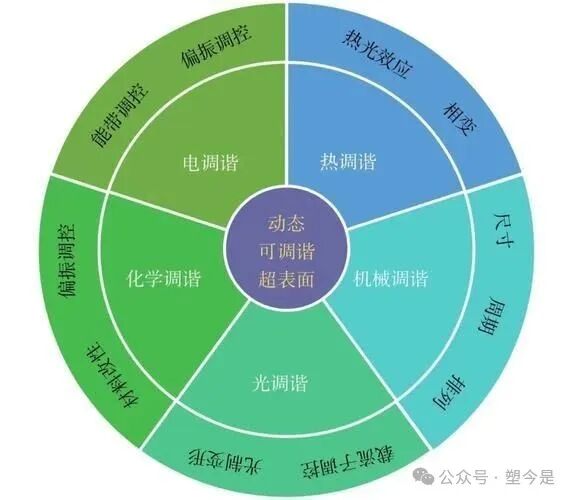
1.Carrier Effect-Based Tuning Technology
This technology mainly adjusts the refractive index by changing the carrier concentration of the semiconductor material (such as injecting electrons or holes) to achieve wavelength tuning. This technology is widely used in tunable lasers, optical filters, optical switches, and other devices.
Introduction toDFR tunable lasers:
Semiconductor lasers that achieve wavelength selection through distributed Bragg reflectors, with the core tuning mechanism based on carrier plasma effects and independent control of multiple regions.DBR lasers consist of three key functional regions:
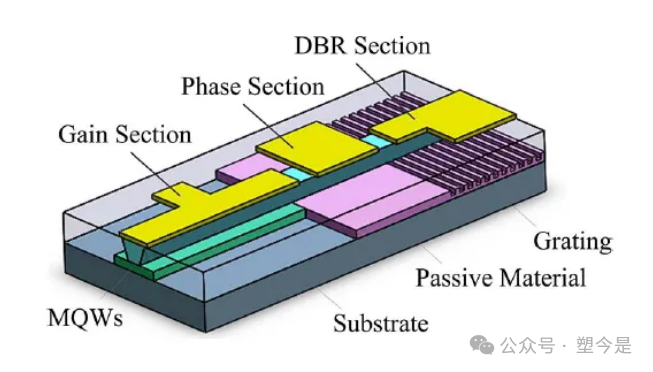
Gain Region(Gain Region):Provides optical amplification, typically usingInGaAsP/InP quantum well structures. Particle number inversion is achieved through current injection, emitting broadband spontaneous radiation.
Phase Section(Phase Section):Adjusts the optical path to ensure that the laser mode matches theDBR reflection peak. The refractive index is altered through carrier injection or thermal effects (Δn), finely tuning the resonant wavelength.
DBR Section(DBR Section):Composed of a grating with a periodically modulated refractive index, reflecting specific wavelengths (Bragg wavelength λB=2neffΛ, where Λ is the grating period). Acts as a wavelength-selective mirror, replacing the end-face mirrors of traditionalFP lasers.
The wavelength tuning of DBR lasers is achieved by independently controlling the currents of the three regions
(1)DBR Region Tuning (Wavelength Selection):

(2)Phase Region Tuning (Mode Matching):Adjusts the refractive index of the phase region to align the longitudinal modes of the laser cavity with theDBR reflection peak, avoiding mode hopping (Mode Hopping).Function:Ensures stable single-mode output and tuning continuity.
(3)Gain Region Control:Provides optical amplification, does not directly participate in tuning, but needs to be optimized in coordination withDBR/ phase regions.
Extended Tuning Technologies
(1)SG-DBR(Sampled Grating DBR):Uses non-uniform sampled gratings in the DBR region to introduce multiple reflection peaks.
By adjusting the reflection peak offsets of the twoDBR regions, an ultra-wide tuning range (40-50 nm, coveringC+L bands) is achieved. For example, Lumentum’s high-performance SG-DBR laser, Coherent’s narrow linewidth DBR laser.
(2)GCSR(Grating Coupled Sampled Reflector):Combines gratings with couplers to further expand the tuning range (up to60 nm). Structure: Gain region + Coupling region + sampled grating region. For example, Santec’s TSL-570 series, EXFOT100S-HP (high-performance GCSR laser), Keysight’s 81600B tunable laser source (including GCSR laser module).
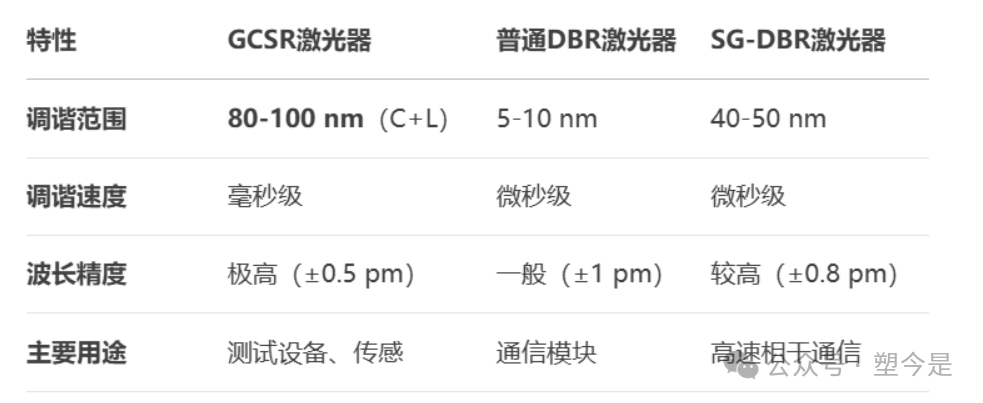
Note
1)C band(1530~1565 nm)is the “golden band” for optical communication, the core of EDFA and DWDM.
2)L band (1565~1625 nm) is used to extend capacity, complementing theC band.
2. Thermal Optical Effect Tuning Technology
(1) Temperature Tuning:Adjusts the laser temperature using a thermoelectric cooler (TEC), utilizing the thermal optical effect of materials (refractive index changes with temperature) to tune the wavelength. The tuning is linear (DFB laser:0.1 nm/°C). The speed is slow (ms level), suitable for static or slowly varying scenarios (such as laboratory spectral analysis).

(Image Source thorlabs)
(2) Localized Heating Tuning:In integrated photonic chips, wavelength-selective tuning is achieved through localized heating of waveguides using micro-heaters. Advantages: low power consumption, suitable for silicon-based integrated devices.
Introduction toDFB Tunable Lasers:
In the active region of the laser (gain region), a periodic grating (periodic refractive index variation) is etched to form distributed feedback. The Bragg reflection condition of the grating determines the laser wavelength, typically operating atλ ≈ 2nₑ꜀Λ(nₑ꜀ is the effective refractive index,Λ is the grating period).
Carrier Plasma Effect (Main Tuning Method):
Current tuning (carrier effect): Increasing the injected current→ increases carrier concentration (electrons/holes) → decreases refractive index (n)(plasma effect) → Bragg wavelengthλ = 2nₑ꜀Λ decreases (blue shift).
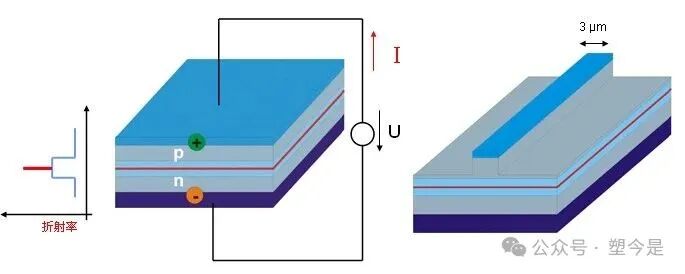
Tuning Range:1-3 nm(limited by carrier saturation concentration), Tuning Speed: Nanosecond level
Key Differences Between DFB and DBR:DFB grating overlaps with the gain region, whileDBR grating is located outside the gain region.
Three Essential Features of DFB Lasers:
Built-in Bragg Grating: The grating is directly etched in the active region (distinct from the external grating region ofDBR lasers).
Distributed Feedback Mechanism: The grating provides continuous feedback over the entire length of the resonant cavity (notDBR‘s end-face reflection).
λ/4 Phase Shift Design: A phase shift is typically introduced at the center of the grating to ensure single longitudinal mode oscillation.
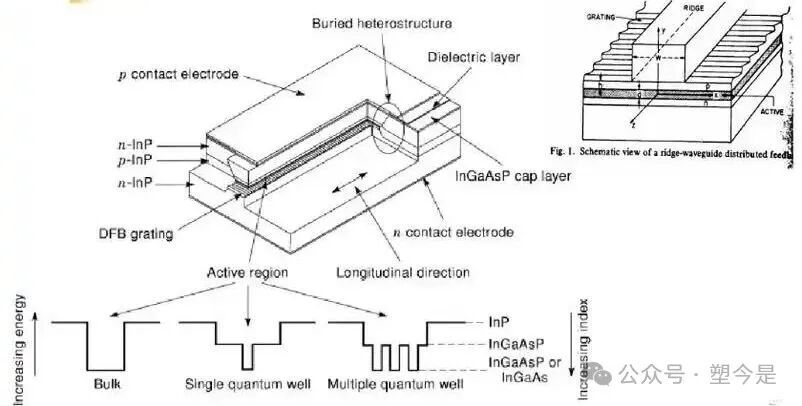
Temperature Tuning (Thermal Optical Effect)::
Increasing temperature→ increases refractive index (n)(thermal optical effect) → Bragg wavelengthλ increases (red shift).
Tuning Range:~5-10 nm(but slower speed, millisecond level).
Segmented DFB
(e.g., SG-DFB): Uses segmented electrodes to independently control different grating regions, extending the tuning range (e.g., 10-15 nm).
Related Products
(1)Communication-grade DFB tunable lasers:LumentummI TLA-DFB-xxx(C-band/T-band),II-VI (Coherent)TDFB-1550 series,Sumitomo ElectricSTF-DFB-xx;
(2)Data Center Specific DFB tunable lasers:NeoPhotonics Nano-ITLA,Huawei HiSiliconTunable DFB,
(3)Special Applications DFB tunable lasers:NTT Electronics narrow linewidth for sensing;ID Quantique quantum communication DFBB;
3. Mechanical Tuning Technology
(1) External Cavity Tuning (ECL):Couples the semiconductor gain chip with an external resonant cavity (such as a grating,MEMS mirror) to mechanically adjust the feedback wavelength.
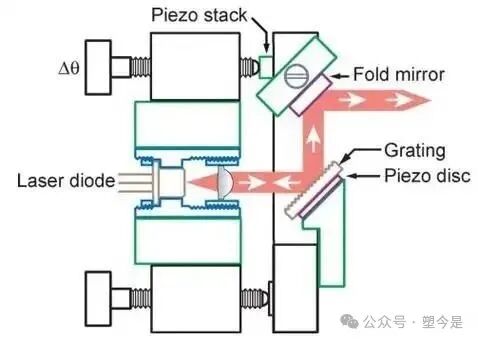
Littrow structure: Direct feedback from a rotating grating.
Littman structure: Fixed grating+ rotating mirror, enhancing wavelength selectivity.

Technical Features: Wide tuning range (50–100 nm); narrow linewidth (<100 kHz), suitable for high-precision spectroscopy. Disadvantages: large size, poor vibration resistance.
For example, Keysight 81600B series Littman-Metcalf external cavity (precision mechanical tuning), Santec TSL-550/570 series fiber Bragg grating (FBG) external cavity.
(2) MEMS Micro-mirror Tuning
Principle: Utilizes micro-electromechanical systems (MEMS) to drive micro-mirrors, rapidly changing the external cavity length or grating angle.
Advantages: Fast tuning speed (μs level); small size, suitable for integration (such as pluggable optical modules).
Applications: Rapidly penetrating communication, LiDAR, consumer electronics three major markets.
For example, Intel’s silicon photonic MEMS laser ( silicon-based MEMS micro-mirror + external cavity feedback), Lumentum’s TMWS series MEMS-tuned vertical cavity surface emitting lasers (VCSEL), STMicroelectronics (STMicroelectronics) MEMS scanning laser module, Hamamatsu (Hamamatsu Photonics) MEMS tunable DFB laser, Thorlabs – MEMS-VCSEL tunable light source, NeoPhotonics – MEMS-ITLA MEMS micro-mirror replacing traditional mechanical optics, TI (Texas Instruments) DLP® MEMS laser projection, Bosch (Bosch) – MEMS laser radar.
4. Electro-Optic Effect Tuning Technology
(1) Electro-Optic Modulation Tuning
Principle: Applying an electric field in electro-optic materials such as lithium niobate (LiNbO₃) to rapidly change the refractive index using thePockels effect.
Technical Features: Ultra-fast (ps level), suitable for ultrafast tuning needs. Narrow tuning range (<1 nm), requires combination with other technologies to extend range. For example, Fujitsu’s lithium niobate electro-optic tunable laser.
(2) Quantum Well Stark Effect Tuning
Principle: Applying an electric field in quantum well structures to adjust the emission wavelength using the quantum confined Stark effect (QCSE).
Applications: High-speed optical switches, tunable VCSELs.
For example, NTT Photonics Laboratories – Electric field-tuned DFB lasers ( based on InGaAsP/InP multi-quantum well structures), Thorlabs – QCSE tunable VCSEL, Hamamatsu – ultrafast QCSE laser module.
5. Integration and Hybrid Tuning Technologies
(1) Monolithic Integrated Tunable Lasers
Technical Approaches:
-InP based integration: Integrating DBR/DFB lasers, modulators, and detectors on the same chip.
– Silicon photonic integration: Combining III-V family gain materials with silicon waveguides through hybrid integration.
– Advantages: Low cost, small size, suitable for large-scale optical communication (such as CPO co-packaged optics).
For example, Intel’s silicon photonic quantum well devices, IMEC (Belgium) silicon nitride platform QCSE devices, Lumentum’s integrated QCSE modulated lasers ( monolithically integrated electro-absorption modulators).
(2) Wavelength Selective Feedback Tuning
Technology:
Ring Resonator Tuning: Utilizing micro-rings or Mach-Zehnder interferometers (MZI) to filter feedback.
Digital Metasurface Tuning: Dynamically controlling feedback wavelength through metasurface structures.
Features: No mechanical movement, fast tuning speed.
6Emerging Tuning Technologies
(1) Quantum Dot Tunable Lasers
Principle: Utilizing the wide gain spectrum of quantum dots (>100 nm) and low threshold current characteristics.
Advantages: Tuning range far exceeds quantum well devices, suitable for multi-band applications.
For example, QD Laser C-band tunable DFB-QD lasers, Innolume high-power quantum dot tunable lasers, Intel silicon-based external cavity quantum dot lasers, IMEC quantum dot micro-ring lasers.
(2) Topological Photonics Tuning
Principle: Achieving low-loss, high robustness tuning based on special optical modes of topological insulator materials.
Status: Experimental stage, potential in interference-resistant communication.
7Comparison Table of Technical Approaches
|
Tuning Technology |
Tuning Range |
Speed |
Complexity |
Typical Devices |
|
Current Injection Tuning |
1–15 nm |
ns level |
Medium |
DFB/DBR lasers |
|
Thermal Optical Tuning |
5–10 nm |
ms level |
Low |
Silicon-based integrated lasers |
|
External Cavity Mechanical Tuning |
50–100 nm |
μs–ms level |
High |
ECL (grating/MEMS)) |
|
Electro-Optic Effect Tuning |
<1 nm |
ps level |
High |
LiNbO₃ modulators |
|
Quantum Dot Tuning |
>100 nm |
ns level |
Medium |
Experimental devices |
8
Future Development Directions
Intelligent Tuning: Combining machine learning to optimize wavelength locking and switching strategies.
Heterogeneous Integration: Efficient fusion of silicon photonic platforms with III-V family materials.
Wide Spectrum Tuning: Breakthroughs in new materials such as quantum dots and topological photonics.
The technical approaches for semiconductor tunable lasers are evolving towards wider, faster, more stable, and more integrated solutions to meet the cutting-edge demands of 5G/6G, quantum communication, and intelligent sensing.

Reading enriches the mind, debate sharpens the wit, notes ensure accuracy, reading history brings wisdom, reading poetry cultivates elegance, mathematics fosters precision, science deepens understanding, ethics instills solemnity, and logic enhances eloquence. All learning shapes character.
——Bacon
The end
Long press the QR code to follow Sujinshi
